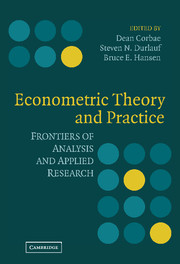Book contents
- Frontmatter
- Contents
- Preface: In Praise of a Remarkable Teacher
- Contributors
- Introduction
- PART I HIGHER-ORDER ASYMPTOTICS
- PART II IV SPECIFICATION TESTS
- 3 Specification Tests with Instrumental Variables and Rank Deficiency
- 4 Asymptotic Normality of Single-Equation Estimators for the Case with a Large Number of Weak Instruments
- 5 Improved Inference in Weakly Identified Instrumental Variables Regression
- PART III NONSTATIONARITY
- PART IV LAD AND QUANTILE REGRESSION
- PART V NONSTATIONARY PANELS
- Index
4 - Asymptotic Normality of Single-Equation Estimators for the Case with a Large Number of Weak Instruments
Published online by Cambridge University Press: 05 June 2012
- Frontmatter
- Contents
- Preface: In Praise of a Remarkable Teacher
- Contributors
- Introduction
- PART I HIGHER-ORDER ASYMPTOTICS
- PART II IV SPECIFICATION TESTS
- 3 Specification Tests with Instrumental Variables and Rank Deficiency
- 4 Asymptotic Normality of Single-Equation Estimators for the Case with a Large Number of Weak Instruments
- 5 Improved Inference in Weakly Identified Instrumental Variables Regression
- PART III NONSTATIONARITY
- PART IV LAD AND QUANTILE REGRESSION
- PART V NONSTATIONARY PANELS
- Index
Summary
INTRODUCTION
Among Peter C. B. Phillips's many contributions to econometrics are two papers exploring the theoretical properties of conventional econometric procedures in models that suffer from a lack of identification. These papers, Phillips (1989) and Choi and Phillips (1992), were the first to derive both finite sample and asymptotic distributions of the instrumental variables (IV) estimator in a simultaneous equations system with identification failure. One of the key findings of Phillips (1989) and Choi and Phillips (1992) is that, when the model is underidentified, the IV estimator is inconsistent and converges to a random variable, reflecting the fact that even in the limit the estimation uncertainty does not go away owing to the lack of identification.
Since the work of Phillips and Choi and Phillips, research on econometric models with identification problems has intensified, and the area is currently one of the most active ones in econometrics. In particular, econometricians have become interested in the case in which the model is weakly identified (or nearly unidentified), which, in the context of an IV regression, translates to the case in which the instruments are only weakly correlated with the endogenous explanatory variables. Indeed, in recent years, it has become popular to model weak instruments using the local-to-zero asymptotic framework of Staiger and Stock (1997), which takes the coefficients of the instruments in the first-stage regression to be in an n-½ shrinking neighborhood of the origin, where n denotes the sample size.
- Type
- Chapter
- Information
- Econometric Theory and PracticeFrontiers of Analysis and Applied Research, pp. 82 - 124Publisher: Cambridge University PressPrint publication year: 2006
- 5
- Cited by



